'Starlight'
Many a modern Astrophotographer having ‘cut his baby imaging teeth’ on the Moon and Sun, has experienced an irresistible urge to ‘have a go’ at Stellar Photography, perhaps even before attempting a planet or two.
So it was with the early pioneers, when on the evening of the 17th of July 1850, John Adams Whipple (1822-1891) and George Phillips Bond (1825-1865), obtained the very first photograph of a star, that of Alpha Lyrae, Vega, using the 15-inch (38cm) Harvard refractor. Its image was captured on a Daguerreotype plate with a 100 second exposure. The second magnitude star Castor (alpha Geminorum) was also photographed and represented the faintest star imaged at that time. Only in the following year of 1851, did Whipple ‘have a go’ at the planet Jupiter.
'The Bonds of Harvard'
Seven years later, G.P. Bond assisted by Whipple and his partner James Wallace Black began using the more sensitive wet collodion process to carry out further experiments in stellar photography. On the 27th of April 1857 they obtained a photograph of the double star Mizar (zeta Ursa Majoris) and its fourth magnitude companion Alcor (80 UMa) They also took images of the double-double star epsilon Lyrae and in doing so capture a star of the sixth magnitude, the faintest imaged at that time.
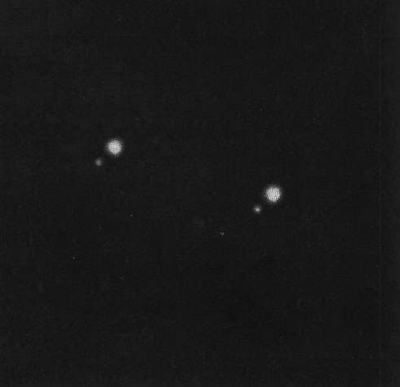
Mizar-Alcor System, Ursa Major, George Phillips Bond, John Adams Whipple, James Wallace Black, Harvard 15-inch 'Great Refractor', 1857
'The Lawyer'
Bond and Whipple’s work on stellar photography was continued by the New York amateur scientist and lawyer, Lewis Morris Rutherfurd (1816-1892). During the years from 1858 to 1877, Rutherfurd took 664 collodion photographic plates of star groups and open clusters, including 54 of the Pleiades (1865-1874) and 23 of the Praesepe (M44) cluster (1865-1877). The faintest stars which appeared on his plates were of magnitude 9 at best. Rutherfurd’s images were obtained with an 11.25-inch ‘photographically corrected’ refractor - it was the very first Astrograph.
'Our Man in Cordoba'
Benjamin Apthorp Gould (1824-1896), the very first astronomer to be awarded a Doctorate in that subject, continued where Rutherfurd had left off. In a ten year period from 1872 to 1882, he and his assistants at the National Observatory of the Argentine at Cordoba took photographs of many of the well known open clusters visible from the southern hemisphere. He was also one of the first to make use of the increased sensitivity of the ‘dry’ photographic plate and managed to obtain images of stars as faint as the tenth magnitude.
'The Nebula Man'
The 30th of September 1880 marked one of the greatest milestones in the history of Astrophotography. On that date, Dr. Henry Draper (1837-1882), the son of the ‘First Astrophotographer’, John William Draper (1811-1882), using an 11.25-inch Alvan Clark photographic refractor obtained the very first photograph of a ‘Deep Space Object', when he imaged the ‘Great Orion’ Nebula (M42). His photograph taken with a ‘dry’ photographic plate and an exposure of 51 minutes became that night one of the most famous ever; and marked the beginning of Deep Space Astrophotography.
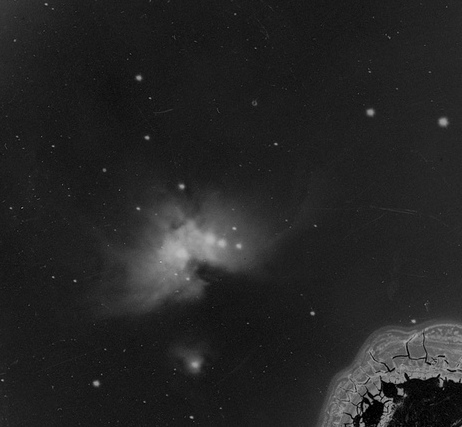
'Great Orion Nebula' (M42), Henry Draper, 11-inch refractor, 1882
Andrew Ainslie Common & Isaac Roberts
Henry Draper died two years later and was unable to continue the great work he had started in the field of Deep Space Astrophotography save to take two improved images of M42. His mantle was taken up by others, including Andrew Ainslie Common (1841-1903) and Isaac Roberts (1829-1904). Common was awarded the Gold Medal of the Royal Astronomical Society of London in 1884 for his astronomical photographs and in particular his image of the ‘Great Orion’ nebula taken on the 28th of February, the previous year. Isaac Roberts was one of the most prolific of all Astrophotographers, taking over two thousand photographic plates. It was his images of well known Deep Space Objects that were the first to show what many of them actually looked like.
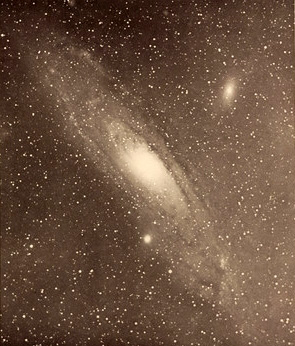
'Great Andromeda Spiral ' (M31), Isaac Roberts, 20-inch reflector, 1888
Other 'Great Astrophotographers'
During the latter part of the nineteenth and early twentieth century, the finest images of Deep Space Objects were obtained by four astronomers in particular - James Edward Keeler (1857-1900) and his assistant Charles Dillon Perrine at the Lick Observatory, using a 36-inch reflector made by Andrew Ainslie Common; George Willis Ritchey (1864-1945) using the 24-inch reflector of the Yerkes Observatory and later the 60-inch Mount Wilson reflector; and the little known Irish amateur William Edward Wilson (1851-1908), using a 24-inch reflector at his Observatory at Daramona.
'Wide Field Astrophotography'
In the field of ‘wide’ Astrophotography Edward Emerson Barnard (1857-1923) and his friend Maximilian Franz Joseph Cornelius Wolf (1863-1932) imaged supreme. During the years 1892 to 1895, Barnard obtained a series of magnificent images of Milky Way starfield and nebulae using the Lick Observatory’s Crocker Astrograph. He followed this up with his ‘Atlas of Selected Regions of the Milky Way’, published posthumously in 1927. The photographs contained in this great work were obtained with Bruce ‘Triple’ Astrograph of the Yerkes Observatory, many of which were actually taken from when the telescope was temporarily situated on Mount Wilson in California in 1904-1905.
Max Wolf at Heidelberg used his 6-inch Double Astrograph from 1891 and then later from 1900 the Observatory’s 16-inch Bruce Double Astrograph to take many magnificent photographs of Nebulae and regions of the Milky Way. It was he who independently discovered the ‘Horsehead’ nebula on a plate taken in 1891, thirteen years after Williamina Fleming first saw it. Wolf also named the famous emission nebula NGC 7000 after the American (North) continent.
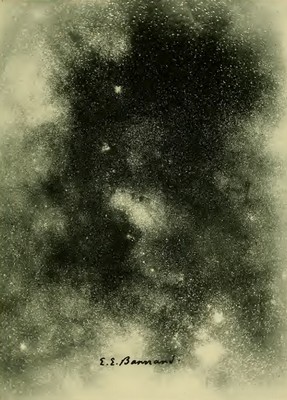
The 'Milky Way' in Sagittarius, Edward Emerson Barnard, 6-inch 'Crocker' Astrograph, c1892
Marcel De Kerolyr - Forgotten Astrophotographer
It was to be a further three decades again before the photographs of Keeler, Ritchey, Wilson, Barnard and Wolf were surpassed in quality by the images of the now forgotten Astrophotographer, Marcel De Kerolyr (1873-1969), taken in the years from 1929 to 1934, using in the main the 80cm reflector of the Astrophotographic station of the Paris Observatory at Forcalquier, France.
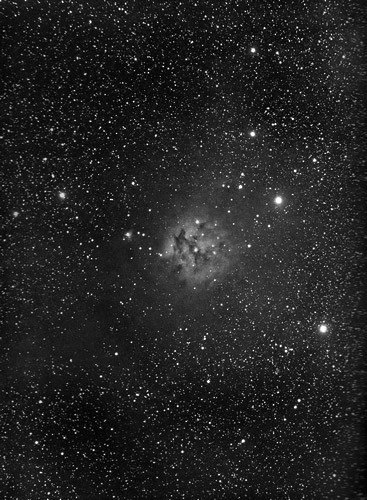
'Cocoon' Nebula (IC 5146) in Cygnus, Marcel De Kerolyr, 1933, 80cm reflector
Quote
“Stellar Photography - Here we are dealing with conditions entirely different...with objects often far beyond the limit of visibility to the unaided eye, and in the case of faint stars and nebulae, often away out of reach of average telescopes. For this class of work the ordinary visual form of telescope, whether reflector or refractor, as used by amateurs, is entirely unsuitable, and unless the worker has a good clock-driven stand, and is prepared to mount a reflector of focal aperture between f/4 and f/5 it is advisable to stick to doublet lenses.”
Henry Hayden Waters (1880-1939), from Astronomical Photography for Amateurs, 1921.
To read more on this subject read the eBook chapter on Deep Space Astrophotography or buy the eBook 'Catchers of the Light'.
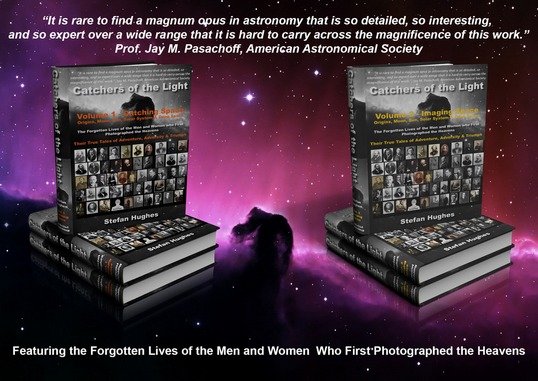
Buy the eBook or Printed Book at the 'Catchers of the Light' shop.